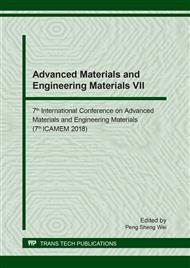p.3
p.8
p.13
p.17
p.22
p.27
p.32
p.37
Trials of Developing a Magnetic Aluminum Metal Matrix Composite through Friction Stir Spot Forming
Abstract:
In present study, possibility of developing a new magnetic aluminum-based composite material by using principles of friction stir forming (FSF) is studied. Friction stir forming is a new materials forming technique which uses frictional heat to plasticize and plastically deform the alloy. Local magnetizing and local hardening of A6061 aluminum alloy is discussed by attempts of embedding and dispersing iron oxide powder and steel balls into A6061 aluminum alloy through spotted friction stir forming. Experiments revealed that FSF can be used to mechanically interlock steel balls and iron oxide with aluminum alloy and develop an aluminum metal matrix composite with improved magnetic properties. Results are discussed in terms of microstructural observation, hardness and magnetic properties.
Info:
Periodical:
Pages:
17-21
Citation:
Online since:
August 2018
Authors:
Price:
Сopyright:
© 2018 Trans Tech Publications Ltd. All Rights Reserved
Share:
Citation:


